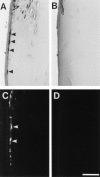Estrogen protects lenses against cataract induced by transforming growth factor-beta (TGFbeta)
- PMID: 9016876
- PMCID: PMC2196117
- DOI: 10.1084/jem.185.2.273
Estrogen protects lenses against cataract induced by transforming growth factor-beta (TGFbeta)
Abstract
Cataract, already a major cause of visual impairment and blindness, is likely to become an increasing problem as the world population ages. In a previous study, we showed that transforming growth factor-beta (TGFP) induces rat lenses in culture to develop opacities and other changes that have many features of human subcapsular cataracts. Here we show that estrogen protects against cataract. Lenses from female rats are more resistant to TGFbeta-induced cataract than those from males. Furthermore, lenses from ovariectomized females show increased sensitivity to the damaging effects of TGFbeta and estrogen replacement in vivo, or exposure to estrogen in vitro, restores resistance. Sex-dependent and estrogen-related differences in susceptibility to cataract formation, consistent with a protective role for estrogen, have been noted in some epidemiological studies. The present study in the rat indicates that estrogen provides protection against cataract by countering the damaging effects of TGFbeP. It also adds to an increasing body of evidence that hormone replacement therapy protects postmenopausal women against various diseases.
Figures




Similar articles
-
17Beta-estradiol confers a protective effect against transforming growth factor-beta2-induced cataracts in female but not male lenses.Exp Eye Res. 2004 Jan;78(1):67-74. doi: 10.1016/j.exer.2003.09.015. Exp Eye Res. 2004. PMID: 14667828
-
Aberrant lens fiber differentiation in anterior subcapsular cataract formation: a process dependent on reduced levels of Pax6.Invest Ophthalmol Vis Sci. 2004 Jun;45(6):1946-53. doi: 10.1167/iovs.03-1206. Invest Ophthalmol Vis Sci. 2004. PMID: 15161862
-
Intravitreal injection of TGFbeta induces cataract in rats.Invest Ophthalmol Vis Sci. 1999 Dec;40(13):3231-6. Invest Ophthalmol Vis Sci. 1999. PMID: 10586947
-
Gender and cataract--the role of estrogen.Curr Eye Res. 2015 Feb;40(2):176-90. doi: 10.3109/02713683.2014.898774. Epub 2014 Jul 2. Curr Eye Res. 2015. PMID: 24987869 Review.
-
Transforming growth factor-beta-induced epithelial-mesenchymal transition in the lens: a model for cataract formation.Cells Tissues Organs. 2005;179(1-2):43-55. doi: 10.1159/000084508. Cells Tissues Organs. 2005. PMID: 15942192 Review.
Cited by
-
Effect of estrogen replacement therapy on lens epithelial cell apoptosis in an experimental rat model.Int Ophthalmol. 2010 Jun;30(3):279-84. doi: 10.1007/s10792-009-9327-6. Epub 2009 Dec 5. Int Ophthalmol. 2010. PMID: 19967548
-
The effects of postmenopausal hormone use on cataract: a meta-analysis.PLoS One. 2013 Oct 24;8(10):e78647. doi: 10.1371/journal.pone.0078647. eCollection 2013. PLoS One. 2013. PMID: 24205286 Free PMC article.
-
Investigation of expression and effects of TGF-β1 and MMP-9 in lens epithelial cells of diabetic cataract rats.Exp Ther Med. 2019 Jun;17(6):4522-4526. doi: 10.3892/etm.2019.7471. Epub 2019 Apr 8. Exp Ther Med. 2019. PMID: 31086584 Free PMC article.
-
The aging human lens: structure, growth, and physiological behaviour.Br J Ophthalmol. 1997 Oct;81(10):818-23. doi: 10.1136/bjo.81.10.818. Br J Ophthalmol. 1997. PMID: 9486018 Free PMC article. Review. No abstract available.
-
Hysterectomy for Benign Indications and Risk of Cataract Formation in South Korean Women.Medicina (Kaunas). 2023 Sep 8;59(9):1627. doi: 10.3390/medicina59091627. Medicina (Kaunas). 2023. PMID: 37763745 Free PMC article.
References
-
- Harding, J.J. 1991. Cataract: Biochemistry, Epidemiology and Pharmacology. Chapman and Hall, London. 83–124.
-
- Schwab IR, Armstrong MA, Frienman GD, Wong IG, Carpantieri AC, Dawson CR. Caratact extraction. Risk factors in a health maintenance organization population under 60 years of age. Arch Ophthalmol. 1988;106:1062–1065. - PubMed
-
- Klein BEK, Klein R, Linton KLP. Prevalence of age-related lens opacities in a population. The Beaver Dam eye study. Ophthalmology. 1992;99:546–552. - PubMed
-
- Thompson JR, Deane JS, Hall AB, Rosenthal AR. Oestrogen and lens opacities in the Melton eye study. Invest Ophthalmol Visual Sci. 1996;37:S585.
Publication types
MeSH terms
Substances
Grants and funding
LinkOut - more resources
Full Text Sources
Other Literature Sources
Medical

